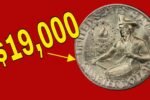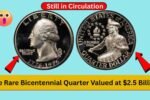The Lincoln Wheat Penny has captivated coin collectors and history buffs for decades. But recent buzz has pushed its allure to a new level — whispers of a version of this iconic coin being worth nearly $4 billion have sparked excitement across the numismatic world. Imagine the possibility: a single penny, tucked away in an old drawer or piggy bank, could be worth more than a luxury mansion.
While some experts debate the legitimacy of the astronomical $4 billion figure, what’s undeniable is the growing curiosity surrounding the Lincoln Wheat Penny — especially the rare 1943 bronze error coin. In this article, we’ll explore the fascinating story behind the Lincoln Wheat Penny, what makes certain versions so valuable, and how you might spot one yourself.
Lincoln Wheat Penny: An American Classic
The Lincoln Wheat Penny, also known as the “Wheat Cent,” was first minted in 1909 to commemorate the 100th birthday of President Abraham Lincoln. Designed by Victor David Brenner, this penny marked a historic shift in U.S. coinage — it was the first American coin to feature a real person’s portrait.
The obverse (front) of the coin displays Lincoln’s profile, while the reverse showcases two wheat stalks framing the words “ONE CENT” and “UNITED STATES OF AMERICA.” These wheat stalks gave the coin its nickname and symbolized American agriculture and prosperity.
The Lincoln Wheat Penny was minted from 1909 to 1958, after which it was replaced by the Lincoln Memorial design.
What Makes the Lincoln Wheat Penny So Valuable?
While most Lincoln Wheat Pennies are only worth between a few cents and a few dollars depending on condition, a select few can fetch jaw-dropping prices — even millions. The most famous of them all is the 1943 Bronze Wheat Penny.
Here’s why it’s special: in 1943, due to copper shortages during World War II, the U.S. Mint began making pennies out of zinc-coated steel instead of copper. However, a few copper planchets (coin blanks) from 1942 accidentally made their way into the presses. The result was a limited batch of 1943 Wheat Pennies struck in bronze — a massive minting error that turned an everyday coin into a rare treasure.
Also Read – Maruti Suzuki Ertiga Launched with Premium Features and Luxury Interior In a Low Budget For Big Families
Some experts estimate that only 10 to 20 of these coins exist today, making them extremely rare. While the rumored $4 billion valuation may be exaggerated, authentic 1943 bronze pennies have sold for upwards of $1 million to $2 million in auctions.
Key Details at a Glance: Lincoln Wheat Penny Facts
| Feature | Details |
|---|---|
| Coin Name | Lincoln Wheat Penny |
| First Minted | 1909 |
| Designer | Victor David Brenner |
| Composition | 95% Copper (some errors in bronze/steel) |
| Notable Rarity | 1943 Bronze Error Penny |
| Rumored Max Value | Up to $4 billion |
| Circulation Status | Rare versions possibly still circulating |
Variants Worth Noting
Besides the 1943 bronze penny, other valuable Lincoln Wheat Pennies include:
- 1909-S VDB: The rarest of the first-issue Wheat Pennies, featuring the designer’s initials “VDB” and minted in San Francisco. Value: $700 – $2,000+
- 1914-D: A hard-to-find coin in good condition from the Denver Mint.
- 1922 No D: A misprint version missing the mint mark, highly sought after.
- 1955 Doubled Die: Shows a double impression of the date and lettering.
Where Might You Find a Rare Lincoln Wheat Penny?
You might be surprised to learn that rare Lincoln Wheat Pennies are still occasionally found in circulation. Some are sitting unnoticed in old coffee tins, coin jars, antique piggy banks, or even in pocket change. People have discovered valuable coins hidden away for decades, completely unaware of their worth.
So if you have access to old coins, whether passed down through family or stored in a jar somewhere, it’s worth checking!
How to Identify a Rare Lincoln Wheat Penny
If you’re hunting for a Lincoln Wheat Penny that could be valuable, look for the following:
- 1943 Copper Color: Most 1943 pennies were made of steel and will stick to a magnet. If yours doesn’t stick and is copper-colored, it might be a rare bronze version.
- Mint Marks: Letters like “S” (San Francisco) or “D” (Denver) below the date can greatly affect value.
- Errors: Look for double dates, missing mint marks, or unusual markings.
- Condition: Coins in mint or near-mint condition fetch much higher prices.
For any penny you suspect might be valuable, have it evaluated by a professional coin grading service such as PCGS or NGC.
Frequently Asked Questions (FAQs)
Q1: Is the $4 billion Lincoln Wheat Penny real?
A1: While some rumors claim this coin exists, no verified sale has reached $4 billion. However, rare Wheat Pennies have sold for over $2 million.
Q2: How can I test if I have a valuable 1943 penny?
A2: Use a magnet. If your 1943 penny sticks, it’s steel (common). If it doesn’t, it may be a rare copper version.
Q3: Can I legally sell a rare Lincoln Wheat Penny?
A3: Yes, you can sell your coin through reputable dealers, auction houses, or online marketplaces. Just ensure it’s appraised first.
Q4: Where should I look for rare coins?
A4: Check inherited collections, thrift shops, estate sales, and even bank rolls.
Q5: Are all Lincoln Wheat Pennies valuable?
A5: No. While some are common and worth only face value, rare variations and errors can be incredibly valuable.
Final Thoughts
The Lincoln Wheat Penny is more than just a piece of spare change — it’s a slice of American history, a collector’s dream, and potentially, a life-changing discovery. While finding a rare penny worth billions may seem far-fetched, stranger things have happened in the world of coin collecting.
So, the next time you get a handful of change, take a closer look. That humble penny could be your golden ticket.
Some Important Link
| Telegram Group | Click Here |
| WhatsApp Group | Click Here |
| Home Page | Click Here |















